Which Asian markets look the cheapest?
Cris Sholto Heaton looks at the valuations of several emerging Asian markets, and finds the cheapest one to invest in now.

A couple of months ago, I wrote about using the price/book ratio to value Asian stocks. At the time, it suggested that while Asia wasn't exceptionally cheap, investing in the MSCI Asia ex Japan regional index was likely to produce a decent medium-term return.
Since then, I've had several requests for an update and for what the same relationship says about individual countries rather than the region.
The former is easy, the latter not quite so straightforward. But I've taken a look at the data and uncovered a few surprises.
MoneyWeek
Subscribe to MoneyWeek today and get your first six magazine issues absolutely FREE

Sign up to Money Morning
Don't miss the latest investment and personal finances news, market analysis, plus money-saving tips with our free twice-daily newsletter
Don't miss the latest investment and personal finances news, market analysis, plus money-saving tips with our free twice-daily newsletter
What the price/book ratio says about Asia now
To recap briefly, the chart below plots end-of-month price/book ratios since 1995 against the annualised market return over the next three years for the MSCI Asia ex Japan. Due to lack of data, this is price return only the effect of dividends is excluded. Dividends will improve returns further.
The relationship obviously isn't perfect, but it's helpful. The price/book ratio clearly gives us some idea of what the chance of a positive return is over the medium term.

The price/book ratio for this index is 1.71, shown above by the red line (the dotted blue line is the average price/book ratio). It suggests we have a good but not exceptional chance of seeing the MSCI Asia ex Japan produce a positive return over three years.
The situation hasn't greatly changed since my last article, when the price/book ratio was around 1.6. Based on history, if it falls to around 1.5, the odds of us getting good returns become better; if it rises to around two, the odds become noticeably worse.
Three things that make price/book useful
Price/book seems to work especially well for this index for three reasons.
First, we have a reasonable amount of data to base it on. It would be good to have a few more years, but while the index goes back to 1988, the valuation data only goes back to 1995. Still, it covers some very volatile times, such as the Asian crisis, the dotcom bubble and the global financial crisis, so it's relatively well tested.
Second, underlying conditions seem consistent. We don't see two or more different blocks within the scatterplot, suggesting that something has changed drastically for example, the index composition being radically different now compared to 1995.
Third, this is a cyclical, volatile index. An indicator like this is much more powerful when a market can go from a price/book ratio ofone tothree in the space of a year and returns go from -30% to 30%. A market like the S&P500 where extremes seem to correct more slowly is less easy to work with.
Five markets where it works well
But while this has worked well for the MSCI Asia ex Japan, it doesn't work so well for all indices and markets. In some cases, data and conditions have changed so much that there isn't a tidy relationship.
In general, it seems to work best with the more established markets in Asia which make up the largest weights in the MSCI Asia ex Japan and is less meaningful for the fastest changing ones.
For example, the MSCI Hong Kong seems to show a relatively consistent relationship. The current price/book ratio of 1.29 has in the past been associated with a good chance of decent returns over the next three years.
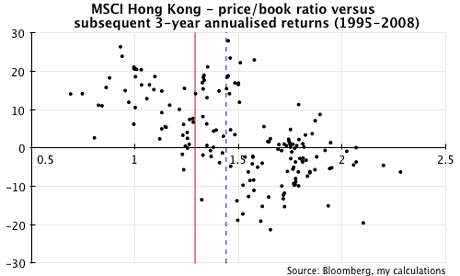
Meanwhile, valuations in Taiwan look less favourable. I wrote a couple of weeks ago that the outlook for Taiwan in the near term does not look good; there's nothing in this chart to make me change my mind.
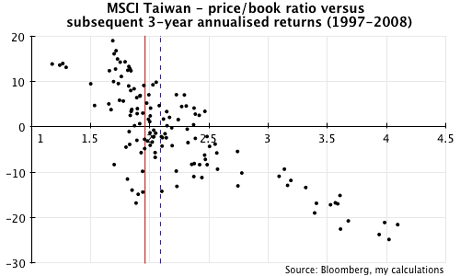
Korea is clearly expensive by historical standards at the moment. Past performance suggests the market could go either way.
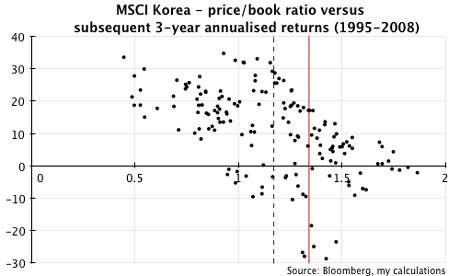
The big question with Korea is whether the increasing success of firms such as Samsung Electronics and Hyundai in building global brands and sales is leading investors to reassess the Korean discount (the persistent tendency for Korean stocks to trade at a discount to most of Asia, reflecting their poor corporate governance record). If that's the case, then a higher price/book ratio may be justified.
Turning to Southeast Asia, Singapore looks pretty cheap by historical standards. These kinds of valuations have almost invariably delivered positive medium-term returns in the past.
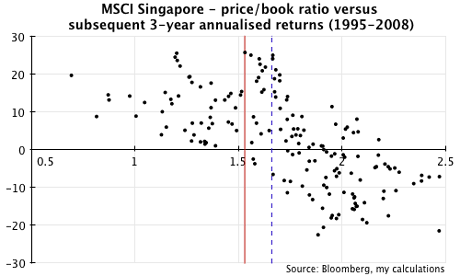
On the other hand, Malaysia looks relatively expensive. Returns seem equally likely to be positive or negative. Attitudes to Malaysia have changed quite a bit in the last few years on the assumption that economic reforms will deliver; the market certainly seems to be pricing that in.
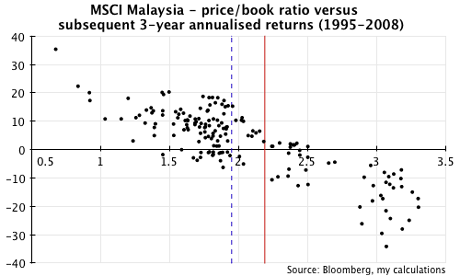
So among these more established markets, where the relationship seems fairly good, it looks as if Hong Kong and especially Singapore offer value.
Korea and Malaysia are not obviously hugely overvalued and may deliver from here but they seem to be getting towards valuations where you need to believe the fundamentals have changed for the better.
As for Taiwan, it's not exceptionally expensive but there seems to be little support from valuations if the news is otherwise bad.
But it's less reliable when conditions are changing
For other markets such as Indonesia, India, the Philippines, mainland China and even Thailand, the history of price/book may not be such a reliable indicator. For example, the chart below shows what's happened in the past with the Philippines.
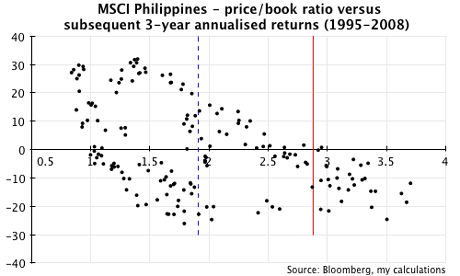
Higher price/book values are still associated with lower returns. But there hasn't been much predictive value at the lower end. In fact, it looks like the scatter breaks into two different trends, which suggests using the long-term history may be undermined by how the market has changed over the last decade or so.
That said, price/book for the Philippines is still high relative to history, at about 50% above its average. The same is true for Indonesia, while Thailand is around 20% higher. On the other hand, India is about 5% below average.
While price/book does not seem to be such a strong indicator of medium term returns for these markets, I still take it into account when thinking about the outlook. Indonesia and the Philippines clearly have a lot of expectations to live up to, while sentiment towards India is pretty muted.
Valuation isn't always everything
But to finish up for this week, one of the best examples of where price/book may need to be treated carefully isn't an emerging market at all. I regularly get told how cheap Japan is on a price/book basis, valued at underone at present.
That's true. But exceptionally low price/book hasn't been a reliable indicator of outstanding medium term returns in Japan over the last decade or so.
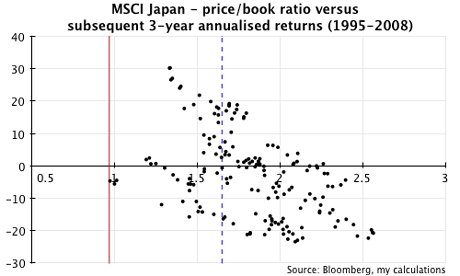
Current valuations are in essentially uncharted territory, right off the left hand end of the scale. You'd hope they'd give 30-40% annualised returns but the fact that this valuation is so far away from normal suggests it would be dangerous to bank on it.
I expect the Japanese market to eventually turn round. But Japan's economic problems are complicated and right now, people don't want to buy Japanese equities. So this is a good example of a market where just looking at valuation may lead you astray.
This article is taken from MoneyWeek Asia, our FREE weekly email on how to invest profitably in the world's fastest-developing and most exciting region. Sign up to MoneyWeek Asia here.
Get the latest financial news, insights and expert analysis from our award-winning MoneyWeek team, to help you understand what really matters when it comes to your finances.
Cris Sholto Heaton is an investment analyst and writer who has been contributing to MoneyWeek since 2006 and was managing editor of the magazine between 2016 and 2018. He is especially interested in international investing, believing many investors still focus too much on their home markets and that it pays to take advantage of all the opportunities the world offers. He often writes about Asian equities, international income and global asset allocation.
Cris began his career in financial services consultancy at PwC and Lane Clark & Peacock, before an abrupt change of direction into oil, gas and energy at Petroleum Economist and Platts and subsequently into investment research and writing. In addition to his articles for MoneyWeek, he also works with a number of asset managers, consultancies and financial information providers.
He holds the Chartered Financial Analyst designation and the Investment Management Certificate, as well as degrees in finance and mathematics. He has also studied acting, film-making and photography, and strongly suspects that an awareness of what makes a compelling story is just as important for understanding markets as any amount of qualifications.
-
 How cancelling unused direct debits could boost your pension by £37,000
How cancelling unused direct debits could boost your pension by £37,000A new year refresh of your spending could save you money and help boost your pension pot.
-
 NS&I cuts interest rates on 8 savings accounts
NS&I cuts interest rates on 8 savings accountsNS&I will now offer less attractive interest rates for customers wishing to lock their savings away to grow for one, two, three or five years.
